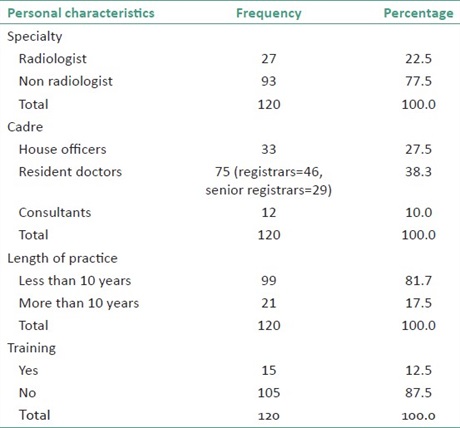Radiation Protection and Dose Awareness Among Doctors in a Nigerian Teaching Hospital: A Preliminary study
Main Article Content
Abstract
Background: Medical imaging using ionizing radiation is an essential tool for diagnosis. Ionizing radiation has adverse biological effects on living organisms and the risk of adverse effects increases with higher doses of radiation. It is the duty of the requesting doctor to balance the risks and benefits of imaging tests involving the use of ionizing radiation. However, previous studies reveal that doctors’ knowledge regarding the radiation doses incurred during diagnostic radiological procedure is inadequate.
Aims: To assess doctors’ knowledge about the guiding principle of radiation protection (As Low as Reasonably Possible (ALARA)) and their knowledge of the radiation doses their patients receive during some common radiological procedures.
Materials and Methods: We adapted the questionnaire used in a previous study and circulated it among 120 doctors from different specialties and cadres. There were questions about cadre, years in medical practice, specialty, and attendance at any training on radiation protection. We asked about nonmedical sources of radiation, the full meaning of ALARA, and the effective doses of ionizing radiation that patients receive during common radiological investigations proportional to chest X-ray. Responses were scored out of a total of 10 marks.
Results: One hundred and twenty doctors participated in the study; 27 radiologists and 93 nonradiologists. The total scores ranged from 1 to 7 marks (mean score=3.38, median score=3.0). Overall, the doctor’s total scores were significantly affected by their specialty and exposure to previous training on radiation protection, with P=0.001 and P=0.001, respectively. Scores were not significantly affected by number of years post qualification.
Conclusion: Level of awareness about the basic principle of radiation protection and patients’ exposure is poor among our study population.
Downloads
Article Details
Section

This work is licensed under a Creative Commons Attribution-NonCommercial 4.0 International License.
This is an open access journal, and articles are distributed under the terms of the Creative Commons Attribution-NonCommercial-ShareAlike 4.0 License, which allows others to remix, tweak, and build upon the work non-commercially, as long as appropriate credit is given and the new creations are licensed under the identical terms.
How to Cite
References
1. Hall EJ, Brenner DJ. Cancer risks from diagnostic radiology. Br J Radiol 2008;81:262‑378.
2. Davies HE, Wathen CG, Gleeson FV. Risks of exposure to radiological imaging and how to minimize the. BMJ 2011;342:589‑92.
3. Lee CI, Haims AH, Monico EP, Brink JA Forman HP. Diagnostic CT scans, assessment of patient, physician, and radiologist awareness of radiation dose and possible risks. Radiology 2004;231:393‑8.
4. Soye JA, Paterson A. A survey of awareness of radiation dose among health professionals in Northern Ireland. Br J Radiol 2008; 81:725‑9.
5. Arslanoglu A, Bilgin S, Kubali Z, Ceyhan MN, Ilhan MN, Maral I. Doctors and intern doctors’ knowledge about patients ionizing radiation exposure doses during common radiological examinations. Diagn Interv Radiol 2007;13:53‑5.
6. Shiralkar S, Rennie A, Snow M, Galland RB, Lewis MH, Gower‑Thomas K. Doctors’ knowledge of radiation exposure: Questionnaire study. BMJ 2003;327:371‑2.


